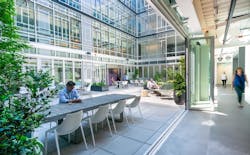Pandemic Will Alter Sustainability Strategies for Buildings
Since the emergence of green building influencers, such as the USGBC, sustainability goals have been understood to necessarily include “people, planet, and profits” if they are to be successful.
Most green building solutions have, until now, been beneficial to all three of those pillars. Reducing carbon emissions, improving air and water quality, and reducing solid waste, have clearly benefited the planet and the people (and other species) inhabiting Planet Earth. Efficiency measures also improve profits by reducing costs. A more efficient HVAC system obviously costs less to operate over its lifetime.
A post-COVID-19 world may look a bit different when it comes to green building.
First, there may be significantly less demand for Class A commercial office space, a significant driver of green building certifications. Balancing social distancing with environmental efficiencies will be a challenge. For example, installing MERV 13 filters in air handlers in order to improve indoor air quality and reduce the spread of airborne illnesses, comes with some penalties. Not only is the first cost higher, when compared to the more common MERV 8 (or less) filters, MERV 13 filters have a higher pressure drop, thereby reducing the overall efficiency of the equipment. Increasing fan sizes to obtain higher air flow rates uses more energy, which of course increases both carbon footprint and cost.
The people benefit, but the planet and profits take a hit. This will be a major challenge to our industry, but successful solutions that benefit both people and the planet will be found. And the providers of those solutions will financially profit.
Since sustainability issues have become forefront in both the scientific and popular press, there has been a growing tendency to link climate-related issues to social justice. We have seen that in several of the so-called “green new deals” proposed by various politicians. And we are told that environmental issues and social justice are inextricably tied, because the environmental and health consequences of climate change disproportionately affect low-income people throughout the world.
That is probably true, but we also must recognize that the science behind climate change is non-arbitrary – in spite of what the climate change deniers believe – while social policy solutions are always arbitrary, since they are offered by people with differing beliefs, backgrounds, and value systems.
Last year, well before the pandemic, a noted academic who has focused on climate action and climate justice for more than a decade, opined that the tendency in the climate change debate was to rely too heavily on green technologies. In a post-pandemic world, those same technologies will be more critical than ever.
COVID-19 restrictions may soon be relaxed throughout the U.S. – and the rest of the world – but our lives will never be the same. Our social mores will be dramatically different, but climate change will still be a threat, and we will still rely on advancing technologies for answers. The solutions to both climate change and pandemics have a common denominator: people, planet, profits. We cannot sacrifice any of them and be successful.
----------------------------------------------
A regular contributor to HPAC Engineering and a member of its editorial advisory board, Larry Clark is a principal at Sustainable Performance Solutions LLC, a south Florida-based engineering firm focusing on energy and sustainability. Email him at [email protected].
About the Author
Larry Clark
A member of HPAC Engineering’s Editorial Advisory Board, Lawrence (Larry) Clark, QCxP, GGP, LEED AP+, is principal of Sustainable Performance Solutions LLC, a South Florida-based engineering firm focused on energy and sustainability consulting. He has more than two dozen published articles on HVAC- and energy-related topics to his credit and frequently lectures on green-building best practices, central-energy-plant optimization, and demand-controlled ventilation.
